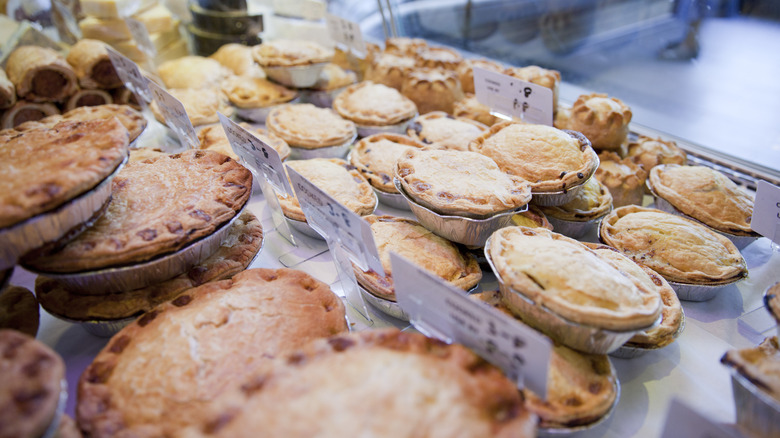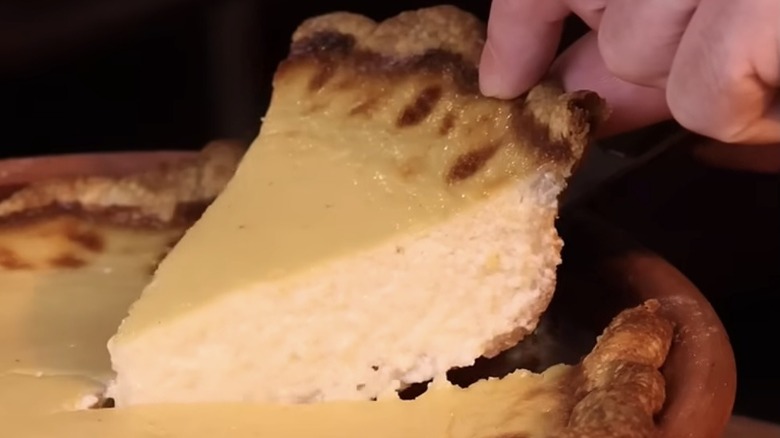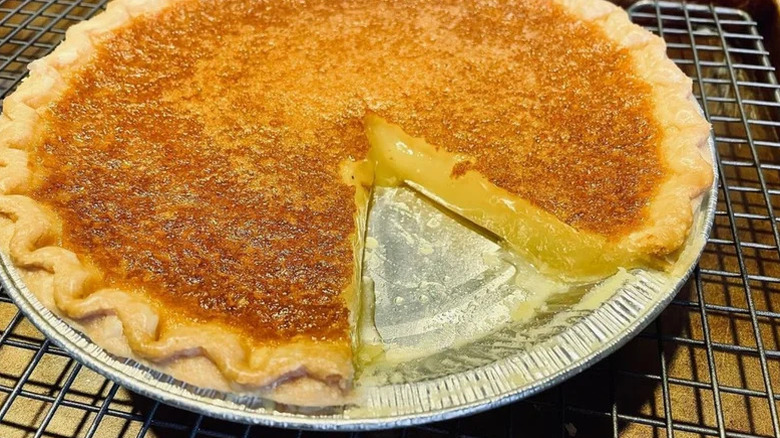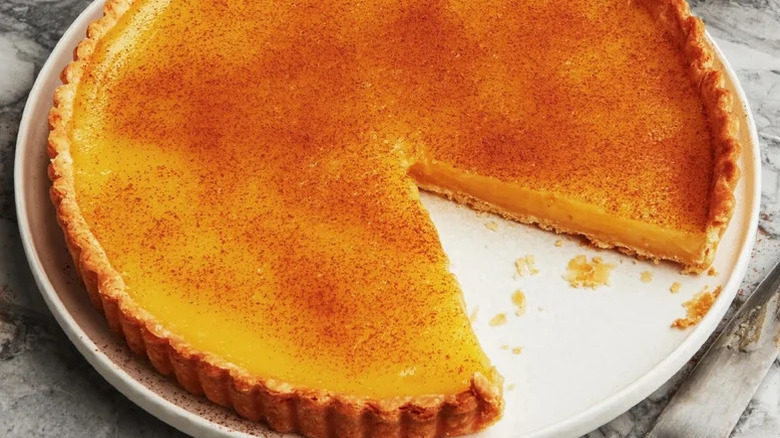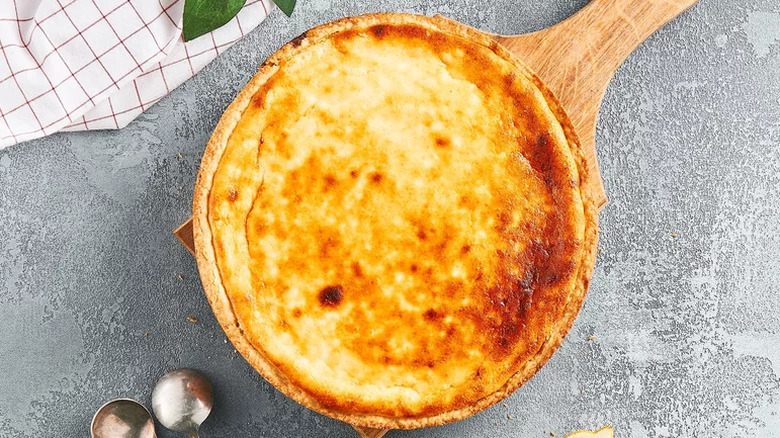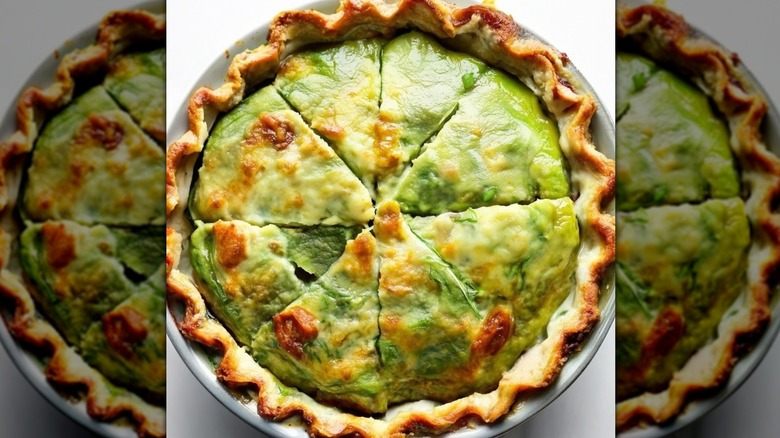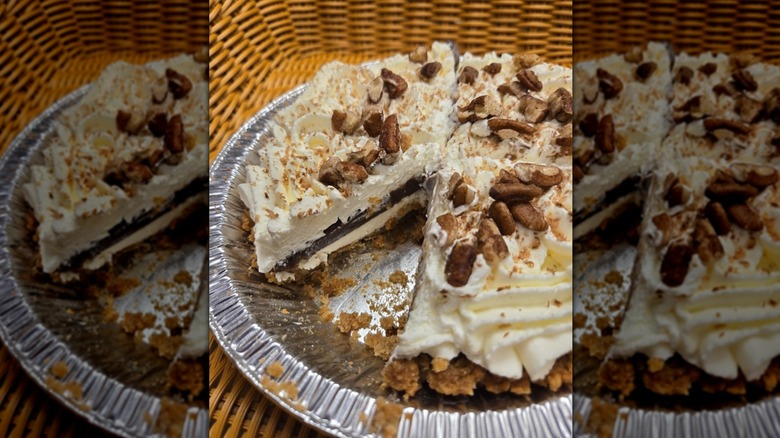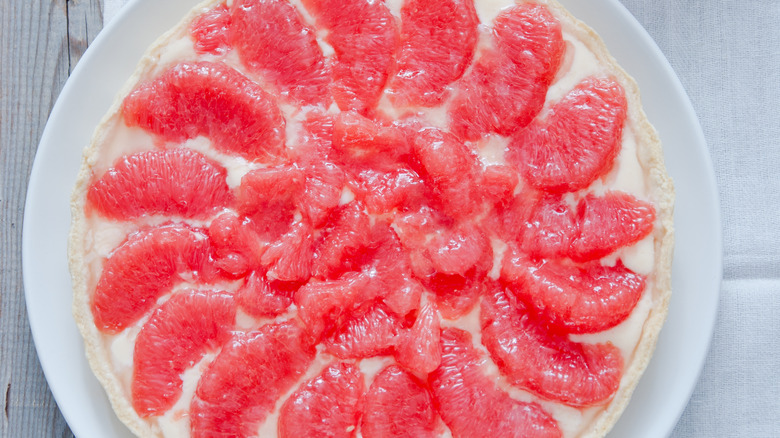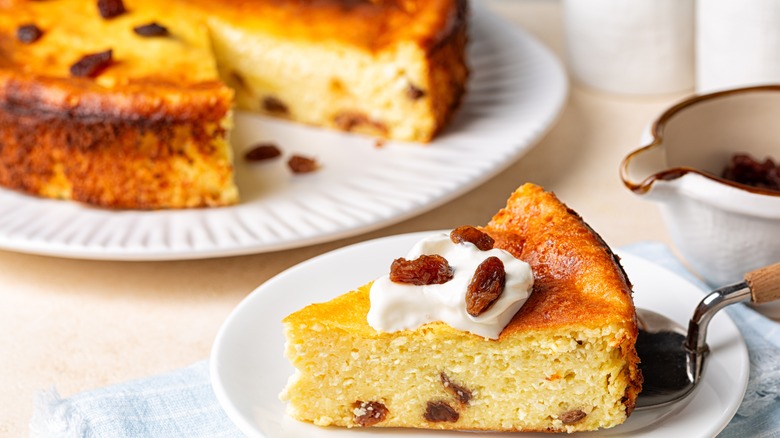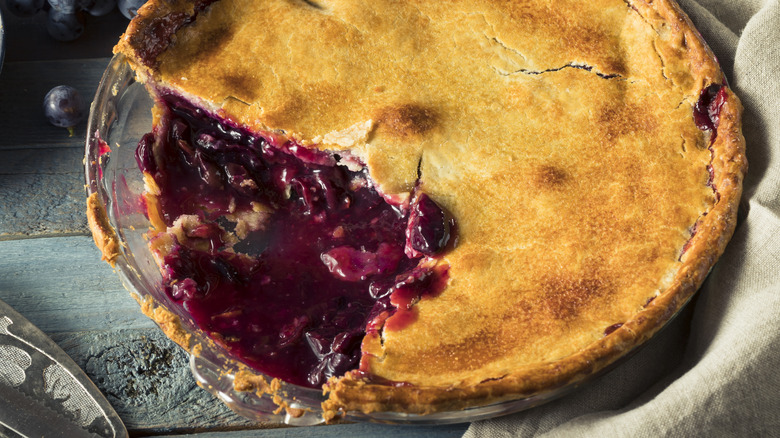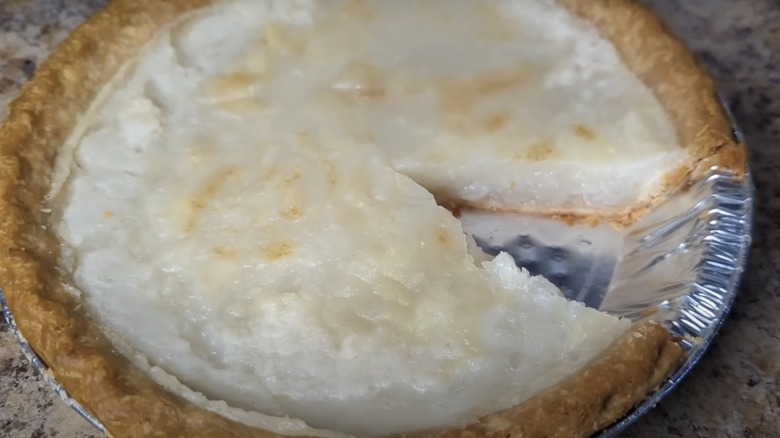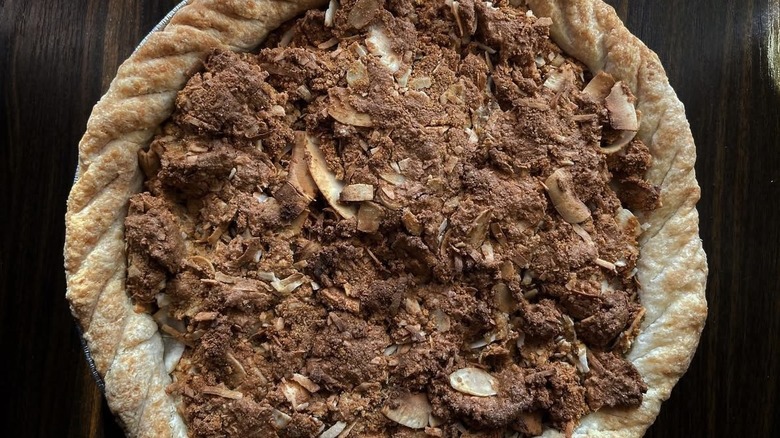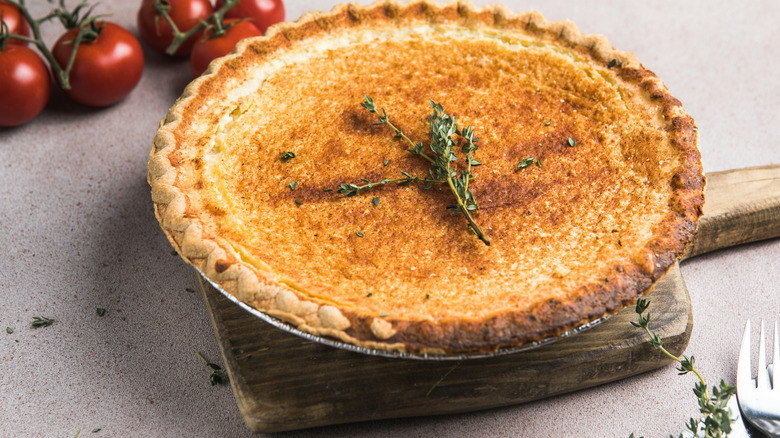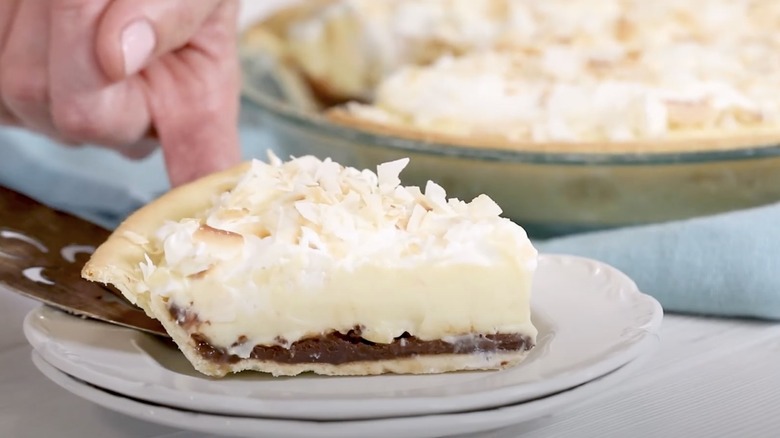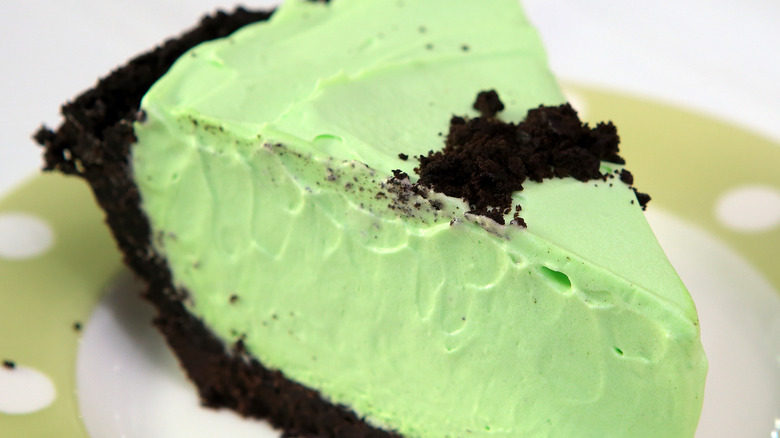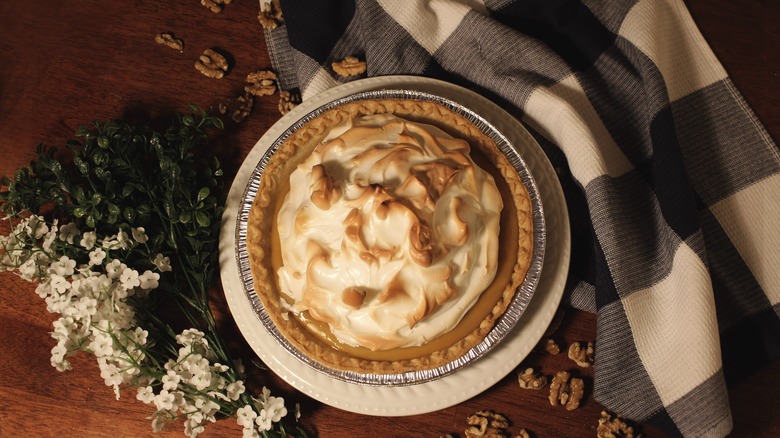Classic Flavors Of Pies That Have Faded Into History
Apple pie may be the standard of Americana, but it has quite a few cousins that have been forgotten over the years. In times of plenty and those of scarcity, at holidays and during periods of mourning, the pie remains a go-to for both comfort and celebration. Thanks to the versatility of the baked concoction, fillings can run the gamut from savory to sweet and — in some instances — have even been inspired by outright mistakes.
While bakeries and restaurants of today may tempt customers with only a handful of offerings, history is chockfull of flavors that have either become regional novelties or have been forgotten entirely. Aside from berries, chocolates, lemons, limes, pecans, and pumpkins, the varieties of pies that have graced windowsills for cooling could leave some asking why they haven't tried that before. Meanwhile, others encountering slices of grasshopper, possum, or sawdust pie could be left asking for clarity on the ingredients.
Marlborough pie
Historically, American society has been known as a melting pot, folding in customs and traditions from afar into one unified dish. The concept can be taken quite literally when considering cuisine as ingredients and their preparations were exchanged overseas. This includes the apple and one popular dessert that reached back to 17th century England that itself is an amalgamation of international fare. Incorporating the fruit with lemon and nutmeg acquired from the Mediterranean and the Spice Islands, Marlborough pie was brought to the Western Hemisphere with one standout flavor that differed from typical apple pies: sherry.
The Spanish wine adds depth to the flavor profile and makes the filling tantalizing enough to be enjoyed as a dessert unto itself in the form of Marlborough pudding. However, the custard-like concoction was not long for the towns of New England as the temperance movement picked up steam throughout the 19th century, ultimately leading to the Prohibition Era of the 1920s. Forcing alcohol underground prior to the Great Depression and World War II marked the beginning of decades of transformation of cuisine, but not before Marlborough pie had cemented its place in history. Though the origin of its name remains unknown, the dessert can be found in what is considered the first American cookbook, "American Cookery" by Amelia Simmons published in 1796.
Transparent pie
Going off the grid may be a trendy way to disconnect from today's era of instant communication that comes from living in the 24/7 information age. But for those setting out across the uncharted frontier, it was simply the way of things. Boldly trekking out into the wilderness and homesteading brought with it rationing and sacrifice. So, having a special treat meant making do with what was on hand. With that in mind, the people of Kentucky are credited with crafting transparent pie with sugar doing the heavy lifting as a main ingredient.
Incorporating butter and sugar, the sweet mixture is added to cream, eggs, flour, and vanilla to form the filling that had long been a treat for those traveling to Magee's Bakery in Maysville, Kentucky. The hometown of George Clooney is still known to have visits from the award-winning actor. However, Magee's Maysville location changed hands in 2019 after the retirement of the owners of 46 years and the Lexington bakery closed down in 2023, putting a damper on area pie sales.
Vinegar pie
The COVID-19 pandemic may have offered Americans a taste of scarcity with supply chain disruptions, but those inconveniences were paltry in comparison to the woes experienced during the Great Depression. Given the extent and sweeping nature of economic hardship, belt-tightening inherently had homemakers turning to creative solutions to satisfy their families. That included expanding the versatility of vinegar to make the acid into a dessert.
As fruits like lemons were costly when they were accessible at all, vinegar was substituted in place of the citrus to create a mock lemon custard. Sugar softened the overpowering pucker potential from the vinegar, leaving those enjoying this iteration of a desperation pie with a similar tart experience of a lemon-based dessert. A couple teaspoons was all it took to come close to the flavor for the once seasonal fruit now readily available at supermarkets year round. As for what kind of vinegar to use, beggars couldn't be choosers and culinary creatives worked with what they had on hand, even if that meant making their own apple cider vinegar.
White potato pie
Where a beloved sweet potato pie remains a common dessert item, especially at holidays, the southern speciality has a lesser known twist with a treat made of its tuberous cousin. Holding a prominent place in the homes of Marylanders in particular, white potato pie recipes can be traced back to the Colonial days of the Old Line State. Both 1747's "The Art of Cookery" by Hannah Glasse and 1824's "The Virginia House-Wife" by Mary Randolph contain variations on potato pudding toward such an end.
Nutmeg, citrus, and a wine or brandy are mixed with creamy buttered mashed potatoes in recipes handed down over the years even into the latter part of the 20th century with Ruth Gaskins "A Good Heart and A Light Hand" cookbook. Still the uncommon variation of a potato dessert mainly remained within the confines of Maryland with popular magazines and cookbooks in the 1980's referring to the dish as Maryland White Potato Pie.
Green tomato pie
Pairing the words tomato and pie together likely leave many envisioning piping hot pizzas with bubbling cheese sliding off a peel and waiting to be sliced. However, this use of tomatoes has nothing to do with marinara sauce and everything to do with arriving at a clever use of unripened fruit to satisfy a craving for apple pie. When the crisp tree-borne fruit are out of season, clever bakers — especially throughout the midwest and the south — turn to the vine for a savory and sweet alternative.
Found in Marion Cabell Tyree's 1877 "Housekeeping In Old Virginia," lemon juice, lemon rind, and sugar are cooked into syrup that slices of green tomatoes are added to and stewed until they become transparent. Added to a pie crust and covered with pastry strips, the dessert can also include typical apple pie spices like cinnamon and nutmeg to fulfill its role as a desperation pie ahead of the apple harvest.
Possum pie
These days, a quick glance at a menu featuring possum pie would surely trigger a double take from the unfamiliar. However, just like its namesake fakes its own demise to avoid predators, this meatless treat plays possum at dessert time. While older volumes of the "The Joy of Cooking" include instructions on care for an opossum before preparing it for a meal, this favorite sweet in Arkansas has nothing to do with small game.
The deceptive dessert typically contains a number of layers composed of chocolate custard, a cream cheese or sour cream, and a whipped topping that may be sprinkled with pecans. Alternate versions incorporate a vanilla pudding into the mix while still others may sneak in a fruit filling. No matter the version, this dessert is known best to the people of the Natural State, particularly in the north and west reaches with most of the pies offering a crushed cookie base made of pecan sandies.
Grapefruit pie
Thoughts of citrus fruit in the United States likely conjure up images of Floridian orange groves while their use in dessert calls to mind lemon meringue or Key lime pies. Setting sail from the Sunshine State across the gulf, sweet-seeking foodies are bound to encounter a treat served up with the official fruit of the state of Texas: the grapefruit. Designated as such in 1993, grapefruit grew to prominence in the Lone Star State after a sustainable crop had been cultivated in the Rio Grande Valley in the early 20th century.
Like Key lime pie, Texas grapefruit pie recipes typically rely on condensed milk for the filling to reach a custard consistency which needs time to set after baking. Once cooled, an extra tangy finish can be added to the dessert by incorporating a layer, or merely an accent, of fresh grapefruit pieces along with a border of whipped cream to offset the splash of ruby red color.
Sour cream raisin pie
Depending on who you ask, raisins are for the health conscious and belong nowhere near desserts — save maybe oatmeal cookies. Those same particular palettes would likely balk at the prospect of coupling dried grapes with sour cream for something meant to be a treat. While the fruit's vineyard varietals are celebrated for providing wine, the shelf stable cousins hold a place of prominence in Iowa with thanks to use in funeral pie.
Credited to the Amish and Mennonite communities of the Hawkeye State, the creation of the sour cream and raisin pie is seen as one of ease and availability riffing off the regular raisin pie that community members cobble together as a go-to for the bereaved. Quick production and a low-risk for spoilage allow focus to be put on mourning. Adding sour cream results in a custard-like version of the dish rarely seen outside of the borders of Iowa where food experimentation goes to extremes each year — like a savory sundae — at the wildly popular Iowa State Fair.
Grape pie
In some instances, uncommon pie flavors have been shown to have fallen out of favor thanks to plenty within the market. Either that, or they've remained a regional trend that faded with time. Neither could be said for grape pie that had earned itself a spot in Irma S. Rombauer's famed "The Joy of Cooking." Though the author was herself from Missouri, these days grape pie has a niche following throughout western New York.
This is especially true around the Finger Lakes that, like Napa Valley, California or Fredericksburg, Texas, are a popular getaway for those looking to soak up the scenery while sipping on wines. Each year, Naples, New York hosts a Grape Festival where attendees can enjoy their favored craft beverages representing the various regions around the bodies of water. Of course, a must-have treat for first-time and annual attendees alike, grape pie can be bought by the slice or as a whole pie.
Water pie
It may sound like a gimmick from a children's fairy tale, but water pie is actually an entirely reasonable and wholly ingenious way to make scant few ingredients stretch when times are tight. Before terms like molecular gastronomy had hit the mainstream and foodies were wowed by the applications of liquid nitrogen, anti-griddles, or use of an electrifying ingredient, the fundamental science behind baking was already being passed down from generation to generation sans much of the jargon.
So it was that the ultimate version of a desperation pie came to be during the Great Depression as the bare minimum of ingredients — butter, flour, and sugar — were coaxed to their fullest to craft a custard out of mostly water. Thanks to the starch, the concoction can hold its shape when baked in a pie crust allowing those living through the lean years a chance to dig into a dessert. When the good times rolled around again, some endeavored to replicate the treat substituting the water with Sprite and results differed due to higher sugar content and the added citric acid.
Sawdust pie
Calling up images of sophomoric pranks in high school shop class, sawdust pie's name certainly is an apt description. But connoisseurs needn't have fear of splintering their tongue. The name for this rustic recipe that once drew the attention of an acclaimed magazine has nothing to do with its flavor and everything to do with the composition. Made with graham cracker crumbs, chopped pecans, and flaked coconut — as well as egg whites and sugar — the finished product has been described by some as more cake-like than pie.
This uncommon dessert can still be found on the menu of Patti's 1880's Settlement more than 40 years after Bon Appétit magazine reached out the proprietor following a diner's attempt to procure the recipe. While owner Patti Tullar had not acquiesced to the customer, she did offer up the details on her dish to the acclaimed publication and it became her first published recipe in 1983. The finishing touch of this Grand Rivers, Kentucky treat remains topping the pie with thinly sliced bananas and whipped cream.
Chess pie
Though claims about the first president felling his father's cherry tree remain dubious, the fruit's inclusion in the foremost first lady's baking is an established fact. Decades before desperation pies became common place throughout the United States, Martha Washington dished out her own version of a chess pie that included a cherry sauce topping. While her iteration of the dessert eventually graced the pages of "The First Ladies Cookbook," detailing recipes fond of each executive from President George Washington through President Lyndon B. Johnson, the Great Depression version is hardly as decadent.
Butter, cornmeal, eggs, sugar, and vanilla make up the limited ingredients of this hard times treat of which the name's origin has been lost to history. While some believe it may have been a riff on storage containers to hold the dessert, called pie chests, others have suggested it to be a variation on pronouncing cheese, as in cheesecake, which has similar qualities to chess pie.
Black bottom pie
Viral videos have likely turned some travelers off from venturing across the not-so-friendly skies after witnessing terminal meltdowns and even in-flight fights. Those longing for the heyday of flying commercial can add drooling over dessert to their want for yesteryear as Delta Airlines once offered catered meals complete with a black bottom pie.
Before it was dished out on tray tables, this pie, typically made with a graham cracker crust that derived its name from the base layer of chocolate cream or pudding, is believed to have first been crafted in the 1940s. Rooted in the south, individual kudos for this whipped cream topped dessert have been given to Monroe Boston Strause. Known for being the man behind the chiffon pie, Strause earned a reputation for sweet innovations and the monikers pie engineer and pie king. Just like decadent desserts being commonplace on domestic flights, this particular pie ultimately went out of fashion.
Grasshopper pie
Some flavor combinations may be timeless, but that doesn't mean that their delivery can stand up to the test of time as equally. So it was that while the pairing of chocolate and mint live on in countless candies, cookies, and ice creams, the cocktail-based grasshopper pie became a dessert of days past. Rather than merely taking inspiration from the profile of the drink traditionally credited to New Orleans bar Tujague's owner Philip Guichet in the lead up to prohibition, this popular sweet throughout the '50s and '60s actually uses the same liqueurs.
After crafting a cookie crust, marshmallow is melted in milk and allowed to cool before equal parts Crème de Cacao and Crème de Menthe are added to the mix. The combination is then poured into a pie shell and allowed to cool. Unlike baked boozy treats, this dessert isn't given the chance to cook off the alcohol, which probably didn't win it much favor with authorities enforcing liquor laws throughout the years. Meanwhile, the cocktail, which you can still find today, deserves more praise.
Butterscotch pie
At the crossroads of necessity being the mother of invention and making lemonade out of lemons, a happy accident resulted in the creation of a candy-inspired pie at the beginning of the 20th century. Roughly 16 years before William and Charles Wheeler opened their first Wheeler's Lunch location outside Indianapolis, their mother was said to have burned some custard. Instead of chucking the result, she repurposed it into a pie filling that the boys enjoyed enough to put on the menu as their chain expanded, and locals gobbled up the butterscotch pie as readily as the Wheelers had.
In fact, when the entrepreneurial Indianans had shuttered their last location in 1969, the Indianapolis Star was left fielding requests from community members to track down and publish the recipe for the pie. Though accessibility for the dessert had faltered, instructions on replicating the candy flavor had been acquired and shared with the masses.

